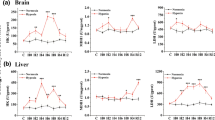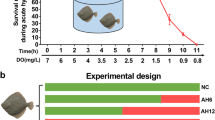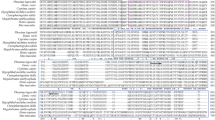Abstract
Amazon fish maintain oxygen uptake through a variety of strategies considered evolutionary and adaptive responses to the low water oxygen saturation, commonly found in Amazon waters. Oscar (Astronotus ocellatus) is among the most hypoxia-tolerant fish in Amazon, considering its intriguing anaerobic capacity and ability to depress oxidative metabolism. Previous studies in hypoxia-tolerant and non-tolerant fish have shown that hypoxia-inducible factor-1α (HIF-1α) gene expression is positively regulated during low oxygen exposure, affecting vascular endothelial growth factor (VEGF) transcription and fish development or tolerance in different manners. However, whether similar isoforms exists in tolerant Amazon fish and whether they are affected similarly to others physiological responses to improve hypoxia tolerance remain unknown. Here we evaluate the hepatic HIF-1α and VEGF mRNA levels after 3 h of acute hypoxia exposure (0.5 mgO2/l) and 3 h of post-hypoxia recovery. Additionally, hematological parameters and oxidative enzyme activities of citrate synthase (CS) and malate dehydrogenase (MDH) were analyzed in muscle and liver tissues. Overall, three sets of responses were detected: (1) as expected, hematocrit, hemoglobin concentration, red blood cells, and blood glucose increased, improving oxygen carrying capacity and glycolysis potential; (2) oxidative enzymes from liver decreased, corroborating the tendency to a widespread metabolic suppression; and (3) HIF-1α and VEGF increased mRNA levels in liver, revealing their role in the oxygen homeostasis through, respectively, activation of target genes and vascularization. This is the first study to investigate a hypoxia-related transcription factor in a representative Amazon hypoxia-tolerant fish and suggests that HIF-1α and VEGF mRNA regulation have an important role in enhancing hypoxia tolerance in extreme tolerant species.



Similar content being viewed by others
References
Affonso EG, Polez VLP, Correa CF, Mazon AF, Araujo MRR, Moraes G, Rantin FT (2002) Blood parameters and metabolites in the teleost fish Colossoma macropomum exposed to sulfide or hypoxia. Comp Biochem Physiol C 133(3):375–382
Almeida-Val VMF, Hochachka PW (1995) Air-breathing fishes: metabolic biochemistry of the first diving vertebrates. In: Hochachka PW, Mommsen T (eds) Biochemistry and molecular biology of fishes, environmental and ecological biochemistry. Elsevier, Amsterdam, pp 45–55
Almeida-Val VMF, Farias IP, Silva MNP, Duncan WP (1995) Biochemical adjustments to hypoxia in Amazon Cichlids. Braz J Med Bioquem Res 28:1257–1263
Almeida-Val VMF, Paula-Silva MN, Duncan WP, Lopes NP, Val AL, Land S (1999) Increase of anaerobic potential during growth of an Amazonian cichlid, Astronotus ocellatus: survivorship and LDH regulation after hypoxia exposure. In: Val AL, Almeida-Val VMF (eds) Biology of tropical fishes. INPA, Manaus, pp 437–448
Almeida-Val VMF, Val AL, Duncan WP, Souza FCA, Paula-Silva MN, Land S (2000) Scaling effects on hypoxia tolerance in the Amazon fish Astronotus ocellatus (Perciformes: Cichlidae): contribution of tissue enzyme levels. Comp Biochem Physiol B 125(2):219–226
Almeida-Val VMF, Chippari-Gomes AR, Lopes NP (2006) Metabolic and physiological adjustments to low oxygen and high temperature in fishes of the Amazon. In: Val AL, Almeida-Val VMF, Randall DJ (eds) Fish physiology, vol 21. Elsevier, Heildelberg, pp 443–500
Almeida-Val VMF, Oliveira AR, Silva MDNPD, Ferreira-Nozawa MS, Araújo RM, Val AL, Nozawa SR (2011) Anoxia-and hypoxia-induced expression of LDH-A* in the Amazon Oscar, Astronotus crassipinis. Gen Mol Biol 34(2):315–322
Baldisseroto B, Chippari-Gomes AR, Lopes NP, Bicudo JEPW, Paula-Silva MN, Almeida-Val VMF, Val AL (2008) Ion fluxes and hematological parameters of two teleosts from the Rio Negro, Amazon, exposed to hypoxia. Braz J Biol 68(3):571–575
Borley KA, Beers JM, Sidell BD (2010) Phenylhydrazine-insduced anemia causes nitrics-oxide-mediated upregulation of the angiogenic pathway in Notothenia coriiceps. J Exp Biol 213(16): 2865–2872
Bracken CP, Whitelaw ML, Peet DJ (2003) The hypoxia-inducible factors: key transcriptional regulators of hypoxic responses. Cell Mol Life Sci 60(7):1376–1393
Brown BA (1976) Hematology: principles and procedures, 2nd edn. Lea & Febiger, Philadelphia
Chellapa S, Yamamoto ME, Cacho MSRF (1999) Reproductive behavior and ecology of two species of cichlid fishes. In: Val AL, Almeida-Val VMF (eds) Biology of tropical fishes. Editora do INPA, Manaus, pp 113–126
Chen L, Endler A, Shibasaki F (2009) Hypoxia and angiogenesis: regulation of hypoxia-inducible factors via novel binding factors. Exp Mol Med 41(12):849–857
Chen N, Chen LP, Zhang J, Chen C, Wei XL, Gul Y, Wang WM, Wang HL (2012) Molecular characterization and expression analysis of three hypoxia-inducible factor alpha subunits, HIF-1α/2α/3α of the hypoxia-sensitive freshwater species, Chinese sucker. Gene 498:81–90
Chippari-Gomes AR, Gomes LC, Lopes NP, Val AL, Almeida-Val VMF (2005) Metabolic adjustments in two Amazonian cichlids exposed to hypoxia and anoxia. Comp Biochem Physiol 141(3):347–355
Crampton WGR (1998) Effects of anoxia on the distribution, respiratory strategies and electric signal diversity of gymnotiform fishes. J Fish Biol 53(A):307–330
Davis JC (1975) Minimal dissolved oxygen requirements of aquatic life with emphasis on Canadian species: a review. J Fish Res Board Can 32(12):2295–2332
Driedzic WR, Almeida-Val VMF (1996) Enzymes of cardiac energy metabolism in Amazonian teleosts and the fresh-water stingray (Potamotrygon hystrix). J Exp Zool 274(6):327–333
Egg M, Köblitz L, Hirayama J, Schwerte T, Folterbauer C, Kurz A, Fiechtner B, Möst M, Salvenmoser W, Sassone- Corsi P, Pelster B (2013) Linking oxygen to time: the bidirectional interaction between the hypoxic signaling pathway and the circadian clock. Chronobiol Int 30:510–529
Ema M, Taya S, Yokotani N, Sogawa K, Matsuda Y, Fujii-Kuriyama Y (1997) A novel bHLH-PAS factor with close sequence similarity to hypoxia-inducible factor 1a regulates the VEGF expression and is potentially involved in lung and vascular development. Proc Natl Acad Sci USA 94:4273–4278
Fontenele O (1951) Contribuição para o conhecimento da biologia do apaiari, Astronotus ocellatus (SPIX) (Pisces, Cichlidae), em cativeiro. Aparelho de reprodução. Hábitos de desova e prolificidade. Rev Bras Biol 11(4):467–484
Gilmour KM (1998) Gas exchange. In: Evans DH (ed) The physiology of fishes. CRC Press, Boca Raton (FL), pp 101–127
Graham JB (ed) (1997) Air-breathing fishes: evolution, diversity, and adaptation. Academic Press, New York
Horowitz JR, Rivard A, van der Zee R, Hariawala M, Sheriff DD, Esakof DD, Chaudhry GM, Symes JF, Isner JM (1997) Vascular endothelial growth factor/vascular permeability factor produces nitric oxide-dependent hypotension. Evidence for a maintenance role in quiescent adult endothelium. Arterio Thromb Vasc Biol 17:2793–2800
Hua Z et al (2006) MiRNA-directed regulation of VEGF and other angiogenic factors under hypoxia. PLoS One 1(1):e116
Huang YS, Huang WL, Lin WF, Chen MC, Jeng SR (2006) An endothelial-cell-enriched primary culture system to study vascular endothelial growth factor (VEGF A) expression in a teleost, the Japanese eel (Anguilla japonica). J Com Biochem Physiol A 145:33–46
Junk WJ, Soares GM, Carvalho FM (1983) Distribution of fish in lake of the Amazon river floodplain near Manaus (Lago Camaleão), with special reference to extreme oxygen conditions. Amazoniana 4:397–431
Kampen EJ, Zijlstra WG (1964) Standardization of hemoglobinometry: III. The hemiglobin-cyanide standard. Clin Chim Acta 6:538–544
Kodama K, Rahman MS, Horiguchi T, Thomas P (2012) Upregulation of hypoxia-inducible factor (HIF)-1a and HIF-2a mRNA levels in dragonet Callionymus valenciennei exposed to environmental hypoxia in Tokyo Bay. Mar Pol Bull 64:1339–1347
Law SH, Wu RS, Ng PK, Richard MK, Kong RY (2006) Cloning and expression analysis of two distinct HIF-alpha isoforms—gcHIF-1alpha and gcHIF-4alpha—from the hypoxia-tolerant grass carp, Ctenopharyngodon idellus. BMC Mol Biol 7(1):15
Lewis JM, Costa I, Val AL, Almeida-Val VMF, Gamperl AK, Driedzic WR (2007) Responses to hypoxia and recovery: repayment of oxygen debt is not associated with compensatory protein synthesis in the Amazonian cichlid, Astronotus ocellatus. J Exp Biol 210(11):1935–1943
Liang D, Chang JR, Chin AJ, Smith A, Kelly C, Weinberg ES, Ge R (2001) The role of vascular endothelial growth factor (VEGF) in vasculogenesis, angiogenesis, and hematopoiesis in zebrafish development. Mech Dev 108(1):29–43
Mohindra V, Tripathi RK, Singh RK, Lal KK (2013) Molecular characterization and expression analysis of three hypoxia-inducible factor alpha subunits, HIF-1α, -2α and -3α in hypoxia-tolerant Indian catfish, Clarias batrachus [Linnaeus, 1758]. Mol Biol Rep 40:5805–5815123
Muusze B, Marcon J, van den Thillart G, Almeida-Val VMF (1998) Hypoxia tolerance of Amazon fish. Respirometry and energy metabolism of the cichlid Astronotus ocellatus. J Comp Biochem Physiol A 120(1):151–156
Nikinmaa M, Rees B (2005) Oxygen-dependent gene expression in fishes. Am J Physiol Regul Integr Comp Physiol 288(5):1079–1090
Nilsson GE, Östlund-Nilsson S (2008) Does size matter for hypoxia tolerance in fish? Biol Rev 83:173–189
Pagès G, Pouysségur J (2005) Transcriptional regulation of the Vascular Endothelial Growth Factor gene—a concert of activating factors. Cardiovasc Res 65(3):564–573
Pelster B, Egg M (2015) Multiplicity of hypoxia-inducible transcription factors and their connection to the circadian clock in the zebrafish. Physiol Biochem Zool 88(2):146
Rahman MS, Thomas P (2007) Molecular cloning, characterization and expression of two hypoxia-inducible factor alpha subunits, HIF-1α and HIF-2α, in a hypoxia tolerant marine teleost, Atlantic croaker (Micropogonias undulatus). Gene 396(2):273–282
Reis RE, Kullander SO, Ferraris CJ (2003) Check list of the freshwater fishes of South and Central America. EDIPUCRS, Porto Alegre, p 729
Richards JG, Wang YS, Brauner CJ, Gonzalez RJ, Patrick ML, Schulte PM, Chippari-Gomes AR, Almeida-Val VMF, Val AL (2007) Metabolic and ionoregulatory responses of the Amazonian cichlid, Astronotus ocellatus, to severe hypoxia. J Comp Physiol B 177(3):361–374
Rimoldi S, Terova G, Ceccuzzi P, Marelli S, Antonini M, Saroglia M (2012) HIF-1a mRNA levels in Eurasian perch (Perca fluviatilis) exposed to acute and chronic hypoxia. Mol Biol Rep 39:4009–4015
Rinaldi L, BassoP Tettamanti G, Grimaldi A, Terova G, Saroglia M, de Eguileor M (2005) Oxygen availability causes morphological changes and a different VEGF/FIk-1/HIF-2 expression pattern in sea bass gills. Ital J Zool 72(2):103–111
Robb T, Abrahams MV (2003) Variation in tolerance to hypoxia in a predator and prey species: an ecological advantage of being small? J Fish Biol 62(5):1067–1081
Rui-Jie S, Xia-Yun J, Jian-Wei P, Shu-Ming Z (2010) HIF-1a and-2a genes in a hypoxia-sensitive teleost species Megalobrama amblycephala: cDNA cloning, expression and different responses to hypoxia. Comp Biochem Physiol B 157:273–280
Rytkönen KT, Renshaw GMC, Vainio PP, Ashton KJ, Williams-Pritchard G, Leder EH, Nikinmaa M (2012) Transcriptional responses to hypoxia are enhanced by recurrent hypoxia (hypoxic preconditioning) in the epaulette shark. Physiol Genomics 44:1090–1097
Rytkönen KT, Prokkola JM, Salonen V, Nikinmaa M (2014) Transcriptional divergence of the duplicated hypoxia-inducible factor alpha genes in zebrafish. Gene 541:60–66
Santos GM, Jegú M, Merona B (1984) Catálogo de peixes comerciais do baixo rio Tocantins. Projeto Tucuruí. Manaus: Eletronorte, INPA. Brasília, DF.-CNPq
Semenza GL (2012) Hypoxia-inducible factors in physiology and medicine. Cell 148:399–408
Semenza GL (2014) Hypoxia-inducible factor 1 and cardiovascular disease. Annu Rev Physiol 76:39–56
Semenza GL, Nejfelt MK, Chi SM, Antonarakis SE (1991) Hypoxia-inducible nuclear factors bind to an enhancer element located 3′ to the human erythropoietin gene. Proc Natl Acad Sci USA 88:5680–5684
Shen RJ, Jiang XY, Pu JW, Zou SM (2010) HIF-1α and -2α genes in a hypoxia sensitive teleost species Megalobrama amblycephala: cDNA cloning, expression and different responses to hypoxia. J Comp Biochem Physiol B 157:273–280
Sloman KA, Wood CM, Scott GR, Wood S, Kajimura M, Johannsson OE, Almeida-Val VMF, Val AL (2006) Tribute to R.G. Boutilier: the effect of size on the physiological and behavioural responses of Oscar, Astronotus ocellatus, to hypoxia. J Exp Biol 209(7):1197–1205
Terova G, Rimoldi S, Corà S, Bernardini G, Gornati R, Saroglia M (2008) Acute and chronic hypoxia affects HIF-1α mRNA levels in sea bass (Dicentrarchus labrax). Aquaculture 279:150–159
Tian H, McKnight SL, Russel DW (1997) Endothelial PAS domain protein 1 (EPAS 1), a transcription factor selectively expressed in endothelial cells. Gen Dev 11:72–82
Val AL, Almeida-Val VMF (1995) Fishes of the Amazon and their environments. Physiological and biochemical features. Springer, Heidelberg
Val AL, Schwantes AR, Almeida-Val VMF, Schwantes MLB (1985) Hemoglobin, hematology, intraerythrocytic phosphates and whole blood Bohr effect from lotic and lentic Hypostomus regani populations (São Paulo-Brasil). J Comp Biochem Physiol B 80(4):737–741
Val AL, Gomes KRM, Almeida-Val VMF (2015) Rapid regulation of blood parameters under acute hypoxia in the Amazonian fish Prochilodus nigricans. Comp Biochem Physiol A 184:125–131
Via JD, Van den Thillart G, Cattani O, Cortesi P (1998) Behavioural responses and biochemical correlates in Solea solea to gradual hypoxic exposure. Can J Zool 76(11):2108–2113
Vuori KA, Soitamo A, Vuorinen PJ, Nikinmaa M (2004) Baltic salmon (Salmo salar) yolk-sac fry mortality is associated with disturbances in the function of hypoxia-inducible transcription factor (HIF-1α) and consecutive gene expression. Aquat Toxicol 68(4):301–313
Wood CM, Kajimura M, Sloman KA, Scott GR, Walsh PJ, Almeida-Val VMF, Val AL (2007) Rapid regulation of Na+ fluxes and ammonia excretion in response to acute environmental hypoxia in the Amazonian oscar, Astronotus ocellatus. Am J Physiol Regul Integr Comp Physiol 292(5):R2048–R2058
Yu RMK et al (2008) Enhancement of hypoxia-induced gene expression in fish liver by the aryl hydrocarbon receptor (AhR) ligand, benzo[a]pyrene (BaP). Aquat Toxicol 90:235–242
Acknowledgments
The authors are grateful to Nazare Paula da Silva, for all logistical support, to the fishermen “China” and Luís, by catching the specimens of Oscar in the field, and to Chris Wood and Gillian Renshaw, for their comments on early versions of this manuscript.
Grants
This work was supported by the Brazilian National Research Council (CNPq), the Amazon State Research Foundation (FAPEAM) and INCT ADAPTA joint grant (CNPq/FAPEAM) to ALV. ALV and VMFAV are the recipients of CNPq research fellowships. RBB was the recipient of a MSc. Fellowship from CAPES.
Author contributions
R.B.B and V.M.F.A.V. were involved in conception and design of research; R.B.B. performed experiments; R.B.B. and N.S.C. interpreted result of experiments; R.B.B and N.S.C. prepared figures; R.B.B drafted the manuscript; A.L.V and V.M.F.A.V. edited and revised manuscript; A.L.V and V.M.F.A.V. approved final version of manuscript.
Author information
Authors and Affiliations
Corresponding author
Ethics declarations
Conflict of interest
No conflicts of interest, financial or otherwise, are declared by the author(s).
Rights and permissions
About this article
Cite this article
Baptista, R.B., Souza-Castro, N. & Almeida-Val, V.M.F. Acute hypoxia up-regulates HIF-1α and VEGF mRNA levels in Amazon hypoxia-tolerant Oscar (Astronotus ocellatus). Fish Physiol Biochem 42, 1307–1318 (2016). https://doi.org/10.1007/s10695-016-0219-1
Received:
Accepted:
Published:
Issue Date:
DOI: https://doi.org/10.1007/s10695-016-0219-1




